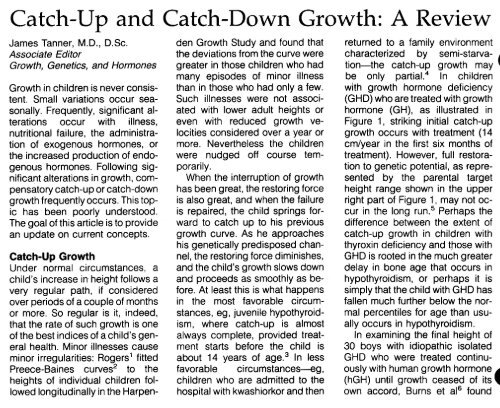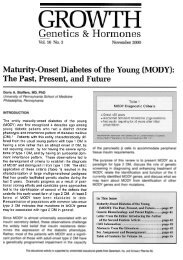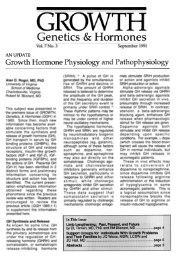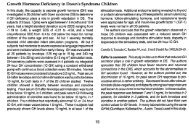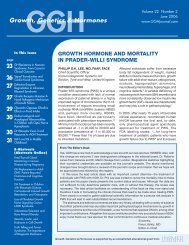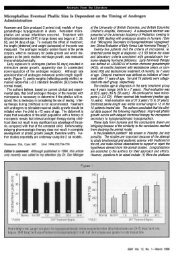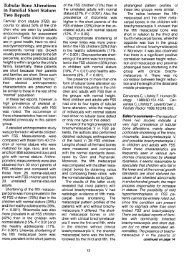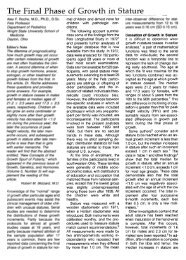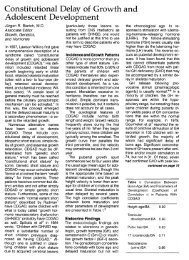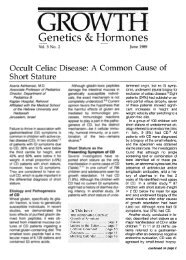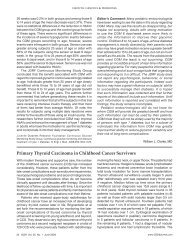Catch-Up and Catch-Down Growth: A Review - GGH Journal
Catch-Up and Catch-Down Growth: A Review - GGH Journal
Catch-Up and Catch-Down Growth: A Review - GGH Journal
Create successful ePaper yourself
Turn your PDF publications into a flip-book with our unique Google optimized e-Paper software.
<strong>Catch</strong>-<strong>Up</strong> <strong>and</strong> <strong>Catch</strong>-<strong>Down</strong> <strong>Growth</strong>: A <strong>Review</strong><br />
James Tanner, M.D., D.Sc. den <strong>Growth</strong> Study <strong>and</strong> found that returned to a family environment<br />
Associate Editor the deviations from the curve were characterized by semi-starva-..<br />
<strong>Growth</strong>, Genetics, <strong>and</strong> Hormones greater in those children who had tion-the catch-up growth may.<br />
many episodes of minor illness be only partial.4 In children<br />
<strong>Growth</strong> in children is never consis- than in those who had only a few. with growth hormone deficiency<br />
tent, Small variations occur sea- Such illnesses were not associ- (GHD) who are treated with growth<br />
sonally. Frequently, significant al- ated with lower adult heights or hormone (GH), as illustrated in<br />
terations occur with illness, even with reduced growth ve- Figure 1, striking initial catch-up<br />
nutritional failure, the administra- locities considered over a year or growth occurs with treatment (14<br />
tion of exogenous hormones, or more. Nevertheless the children cm/year in the first six months of<br />
the increased production of endo- were nudged off course tem- treatment). However, full restoragenous<br />
hormones. Following sig- porarily. tion to genetic potential.. as reprenificant<br />
alterations in growth, com- When the interruption of growth sented by the parental target<br />
pensatory catch-up or catch-down has been great, the restoring force height range shown in the upper<br />
growth frequently occurs. This top- is also great, <strong>and</strong> when the failure right part of Figure 1, may not ocic<br />
has been poorly understood. is repaired, the child springs for- cur in the long run.5 Perhaps the<br />
The goal of this article is to provide ward to catch up to his previous difference between the extent of<br />
an update on current concepts. growth curve. As he approaches catch-up growth in children with<br />
his genetically predisposed chan- thyroxin deficiency <strong>and</strong> those with<br />
<strong>Catch</strong>-<strong>Up</strong> <strong>Growth</strong> nel, the restoring force diminishes, GHD is rooted in the much greater<br />
Under normal circumstances. a <strong>and</strong> the child's growth slows down delay in bone age that occurs in<br />
child's increase in height follows a <strong>and</strong> proceeds as smoothly as be- hypothyroidism, or perhaps it is<br />
very regular path, if considered fore. At least this is what happens simply that the child with GHD has<br />
over periods of a couple of months in the most favorable circum- fallen much further below the noror<br />
more. So regular is it, indeed, stances, eg, juvenile hypothyroid- mal percentiles for age than usuthat<br />
the rate of such growth is one ism, where catch-up is almost ally occurs in hypothyroidism.<br />
of the best indices of a child's gen- always complete, provided treat- In examining the final height of<br />
eral health. Minor illnesses cause ment starts before the child is 30 boys with idiopathic isolated<br />
minor irregularities: Rogers 1 fitted about 14 years of age.3 In less GHD who were treated continu-<br />
Preece-Baines curves2 to the favorable circumstances-eg, ously with human growth hormone<br />
heights of individual children fol- children who are admitted to the (hGH) until growth ceased of its ,<br />
lowed longitudinally in the Harpen- hospital with kwashiorkor <strong>and</strong> then own accord, Burns et al6 found
that only the st<strong>and</strong>ard deviation "Compensatory deceleration" has the correlation coefficient had ris-<br />
(SO) score for height at the begin- been suggested. The term "catch- en to 0.5; by one year, it had risen<br />
t ning of treatment (with allowances down," however, originally sug- to 0.7; by two years the stable premade<br />
for parental heights) was gested as a linguistic joke, seems pubertal value of 0.8 was reached.<br />
important. The lower the SO score to have caught on. Not all children Thus, during infancy a reasinitially,<br />
whatever the child's age, treated with GH exhibit this sortment of relative sizes among<br />
the lower the final height, by some marked deceleration in com- children comes about: Those who<br />
2.5 cm for each SO score below parison with pretreatment growth are larger at birth grow less; those<br />
the mean for the group. Of the 6 SO rates. The reason for the differ- who are small grow more. Figure 3,<br />
lost by untreated GHO patients be- ences between children remain from an old but comprehensive<br />
fore GHO was recognized, we obscure. study,8 illustrates this. It should be<br />
were able to restore 4 SO on aver- noted that the velocity curves for<br />
age, but we were not able to re- <strong>Catch</strong>-<strong>Up</strong> <strong>and</strong> <strong>Catch</strong>-<strong>Down</strong> as weight of only the extreme birth<br />
store the other 2 SO. This was true Normal Occurrences weight cohorts of 5 to 61bs <strong>and</strong> 9 to<br />
even in patients who received In infancy, catch-up <strong>and</strong> catch- 10 Ibs are shown. In a classic patreatment<br />
as early as four years of down growth occur as normal per, Smith et al9 described the<br />
age.7 In those first few years of phenomena. Soon after the longi- same thing in American middlerapid<br />
growth, a deficit that is only tudinal data for growth from birth to class, well-nourished babies.<br />
partly recoverable seems to ac- maturity became available, it was In fact, the curves shown in Figcumulate.<br />
We do not know why this shown that the correlat[ons be- ure 3 conceal heterogeneity. Not<br />
is so. tween measurements taken in an all 9-pounders grow especially<br />
individual child at various ages- slowly, only those whose genes<br />
<strong>Catch</strong>-<strong>Down</strong> <strong>Growth</strong> birth, one month, three months, six specify an average adult size but<br />
<strong>Catch</strong>-down growth is the oppo- months, <strong>and</strong> so on-<strong>and</strong> his or her whose maternal uteruS was highly<br />
site of catch-up growth. If growth is measurements .as an adult had a stimulatory. Some of the 9-pound.:<br />
artificially stimulated <strong>and</strong> then the characteristic temporal pattern. ers come by it honestly: large at<br />
stimulating force is withdrawn, the The correlation between length at birth <strong>and</strong> large later. But the others<br />
growth velocity drops for a while, birth <strong>and</strong> adult height was low (ap- slow down until they hit their<br />
as shown in Figure 2. We need a proximately 0.3). By six months, proper curves. Likewise, the small<br />
term for this phenomenon, <strong>and</strong><br />
~ none has been forthcoming.,<br />
Figure 2. Catcn-down growth in a patient receiving growth<br />
hormone on two occasions separated by a year without<br />
treatment. The growth velocity off treatment is significantly<br />
Figure 1. Partial catch-up growth in a boy with idiopathic lower than the pretreatment velocity. The growth<br />
isolated growth hormone deficiency treated with velocity on treatment also wanes with extended treatment.<br />
growth hormone. cm<br />
-y;:c<br />
23 .~---<br />
: BOYS Heightvek>City --== .'<br />
180 BOYS He~ht<br />
22<br />
:<br />
,--<br />
.-q<br />
-OJ)<br />
~ ,<br />
C R 0 21 : 20 .__dq ,., .~<br />
170<br />
160 .~ =, §: 18 19 \ :<br />
w ,<br />
17 :<br />
150., :<br />
';;:::.-. 16 :<br />
'__I :<br />
140' 15 :<br />
14 :<br />
130' 13 : :: '<br />
120 12 ~ .<br />
11 : .<br />
110 10 :<br />
x : HGH hGH<br />
9 .-<br />
100 :<br />
8 :. ..<br />
..<br />
90 7 : :<br />
6 "<br />
80 ,:<br />
5 .<br />
70<br />
80~<br />
50 1 2 3 4 5 7 8 9 10 11 12 13 14 1 18 19<br />
"<br />
continued on page 10
<strong>Catch</strong>-<strong>Up</strong> <strong>and</strong> Figure 3. Weight velocity curves of cohorts of babies weighing 5 to 6 Ibs<br />
Cat~h-<strong>Down</strong> <strong>Growth</strong> <strong>and</strong> 9 to 10lbs at birth. As a group. the smaller infants grow more rapidly<br />
continued from page 9 than the larger infants. ()<br />
babies with genes for average final ", Boys<br />
height catch up to their proper ~ :~ (-'\,<br />
curves, a process usually completed<br />
by about 12 months. This<br />
.~<br />
Co<br />
::<br />
c,<br />
was already well know~ to anim~1<br />
~<br />
3:<br />
"<br />
~: Birth weight<br />
breeders: If a large Shire horse IS ~ ". (in pounds)<br />
pony, crossed the with size of a the small newborn Shetl<strong>and</strong> foal -: g '0 -g ~: "0 '0 ." '0 '0 00 90 ; '00 "0 '00 "0 "0<br />
closely follows the size of the ~ g Age in weeks<br />
mother.1O But the tiny foal of the ~ ~ :: Girls<br />
Shetl<strong>and</strong> mother has half of its<br />
height-determining genes from its<br />
.~:=.::<br />
~ c.<br />
,-'--<br />
". '--,<br />
great Shire father, just as the large .5 ::<br />
Shire-mother foal has genes from<br />
its small Shetl<strong>and</strong> father. After a<br />
nearly few months, the same the size. two foals are<br />
~<br />
~<br />
.5 (,)<br />
~:<br />
".<br />
o. '" 00 ~ '0.0 so 60 '0<br />
Birth weight<br />
(in p~unds)<br />
00 90 , ~" "0 ...0 "0 "0 "0<br />
The Mechanism of <strong>Growth</strong><br />
Age in weeks<br />
Regulation<br />
<strong>Catch</strong>-up <strong>and</strong> catch-down growth theoretically as maturity increases. Mosier thinks otherwise: The conare<br />
simply exaggerated forms of If this is true, there must be another trol resides in a sizostat, which the<br />
normal growth regulation. We do signal that tells the animal what irradiation has damaged. This is<br />
not know how the extraordinary size it actually is, perhaps by syn- the explanation I gave for the seemprecision<br />
of growth is maintained thesizing another series of mol- ingly unalterable short stature of<br />
or how it is, for example, that ecules, this time in strict proportion children with early intrauterine lemonozygotic<br />
twins who differ by to the amount of growth. Theoreti- sions (eg, Silver-Russell syn- .<br />
3 cm in length at birth grow so that cally, these molecules would enter drome). Mosier has very recently.<br />
there is only a 1-cm difference in the central nervous system to in- localized the effect of head irradiadult<br />
height. We do not even know teract with the size-stuff <strong>and</strong> bind ation to the midline structures,<br />
how the normal rate of growth is to it so that only a certain amount probably the suprachiasmatic<br />
established or why the velocity of is left. This remaining amount is nucleus.<br />
growth in general diminishes as the mismatch signal that controls This model may, of course, be<br />
a child gets older. When we fit the output of growth-stimulating erroneous since the evidence is far<br />
curves to the growth of individuals, hormone. from conclusive. Perhaps all reguwe<br />
use equations, nearly all of<br />
which assume that growth velocity<br />
Recently, Mosier <strong>and</strong> his colleagues<br />
12-14 designed experilation<br />
takes place in the generative<br />
<strong>and</strong> proliferative layers of carat<br />
any time is a function of the ments to test this model. If rats tilage, with each cell having its inremaining<br />
growth or, what is the have their heads irradiated shortly trinsic rhythm of division <strong>and</strong> gathsame<br />
thing, the percentage of after birth, their subsequent ering a greater need to divide the<br />
height completed. But how does growth will be stunted. If tested longer it lacks the necessary local<br />
the child "know" what percentage later, after a 48-hour fast, their ca- hormone to do so. However this<br />
he has attained? pacity for catch-up will not be im- may be, the physiology of normal<br />
Many years ago, I suggested a paired; they catch up to their growth control is clearly the key to<br />
"central" model to explain this,11 control-irradiated curve but not to underst<strong>and</strong>ing catch-up <strong>and</strong><br />
but "peripheral" models are also a normal-control curve. The catch- catch-down growth, as well as the<br />
possible. In the central model it is up of normal rats starved for 48 effect of the various therapeutic<br />
supposed that some sort of "sizo- hours is associated with an in- interventions now being used or<br />
stat" exists in the central nervous creased amplitude but not fre- considered for the treatment of all<br />
system; the sizostat tells the ani- quency of GH pulses, especially sorts of short stature.<br />
mal what size it "ought" to be at during the light part of the light- References<br />
The each .si.zostat moment could during do th!s its growth. by syn- dark rats secrete cycle. Although a lit~le less the GH irradiated t~an do Uni~er~~~r~Xf~rd,<br />
1 RAM 'En~i<strong>and</strong>~~1~84.<br />
Ph'l Th .0 x f ord<br />
theslzlng <strong>and</strong>/or releasing every normal rats during both their con- 2. Preece MA Baines MJ. Ann Hum<br />
so often, for example, a specific trol <strong>and</strong> catch-up growth, this does 8io/1978:5:1-24:<br />
molecule not yet identified. The not necessarily mean the differ- 3. Van Harnack GA et al. Eur J Pediatr I<br />
rate of synthesis would decrease ence in GH secretion.is causative. 1972;112:1-17.
4. Prader A et al. J Pediatr 1963; 8. St<strong>and</strong>ards of normal weight in in- 12. Mosier HO Jr. et al. <strong>Growth</strong><br />
62:646-659. fancy. Ministry of Health Report, Public 1983;47:13-25.<br />
5. Tanner JM. Br Med Bull 1981; Health No. 99. London, HMSO, 1959. 13. Mosier HO Jr. Pediatr Res,<br />
37:233-238. 9. Smith OW et al. J Pediatr 1985;19:543-548.<br />
6. Burns EC et al. Eur J Pediatr 1976:89:225-230. 14. Mosier HO Jr. et al. Pediatr Res<br />
1981 ;137:155-164. 10. Walton A et al. ProcSocLond {Bioi] 1986:20:261-264.<br />
7. Tanner JM. In: Human <strong>Growth</strong>, 2nd 1938;125:311-335.<br />
edition, Vol 1. New York, Plenum, 1986, 11. Tanner JM. Child Dev 1963:<br />
167-179. 34:817-847.


